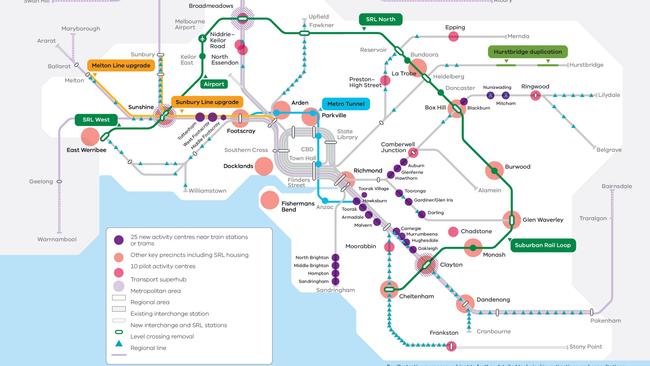Experts reveal how many homes would be eligible for demolition in Allan Government planning overhaul
Up to 400 suburban homes could be razed to make way for apartment towers or townhouses under the Allan government’s “radical” activity centres plan.
Victoria
Don't miss out on the headlines from Victoria. Followed categories will be added to My News.
Up to 400,000 suburban homes would be eligible for demolition and replacement with apartment blocks or townhouses under the Allan Government’s “radical” reshaping of Melbourne, a new report says.
The report, by a group of experts planners called Charter 29, assessed recent housing policies announced by the Government – including for 60 high rise precincts around railway stations and jobs hubs.
Those precincts, called activity centres, are set to include a “core” where towers between 12 and 20 storeys could be allowed, as well as a “walkable catchment” within 800 metres, for developments up to six storeys.
Similar precincts are proposed within 1.6km of stations along the contentious $34.5bn Suburban Rail Loop East, between Cheltenham and Box Hill.
The Charter 29 report says 300,000-350,000 properties were likely to be earmarked for development within activity centres, based on average numbers of dwellings within activity centres already announced – such as in Brighton, Frankston, Ringwood, Toorak and West Footscray.

“When the six extensive Suburban Rail Loop East precincts are added, up to an estimated 400,000 families would be displaced, and much of Melbourne’s built heritage and high amenity suburbs would be lost,” it says.
“It would overload existing infrastructure and services such as schools, preschools, hospitals and parks, and cause major road traffic congestion.”
The authors, who include academics, architects and urban designers Michael Buxton, Steve Thorne, Jim Holdsworth, Geoffrey Falk and Mike Scott, propose an alternative strategy to squeeze an extra 2 million homes in Victoria by mid-century, such as by identifying high intensity development opportunities in existing zones through a lot-by-lot analysis.
“It is not necessary to demolish a city to save it,” the report says.
It says residents are set to lose their rights to be notified about development proposals or to appeal, and questions affordable housing components of the plans because “high rise apartments are the most expensive construction types per occupant”.
“Replacing expensive houses with multimillion-dollar apartments is doing nothing for affordable housing provision,” it says.
Mr Buxton, who is RMIT Emeritus Professor of Environment and Planning, said the group consulted widely with the industry before publishing the report, and accused the Government of treating residents like “the enemy”.
A spokesperson for the Government said Mr Buxton was spreading “lies and fear” and it was wrong to suggest heritage overlays would be changed within activity centres or that public notice or third-party appeal rights will be taken away “for taller buildings up to the six storey limit in the walkable catchments”.
“Building more homes around 50 inner-suburban train stations means young people have more opportunity to rent or buy a place that’s directly connected to public transport.”
matthew.johnston@news.com.au



